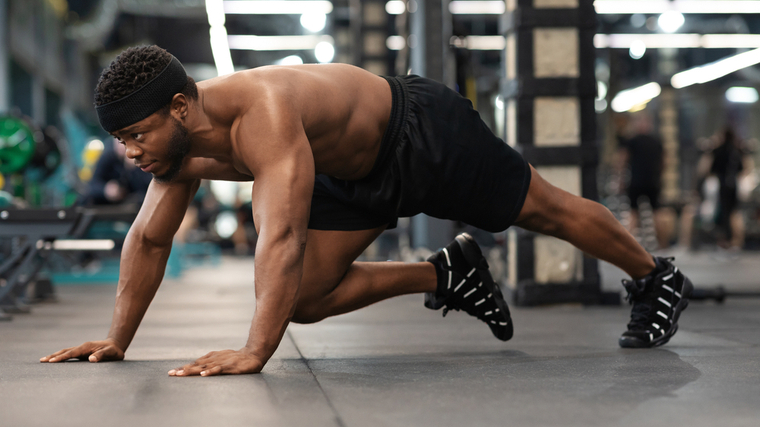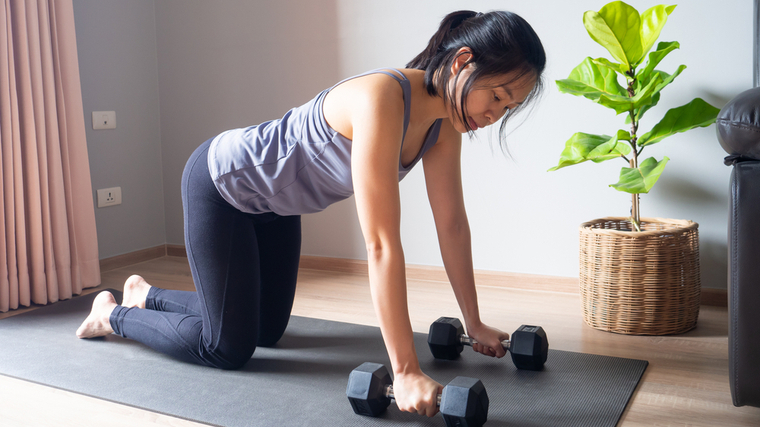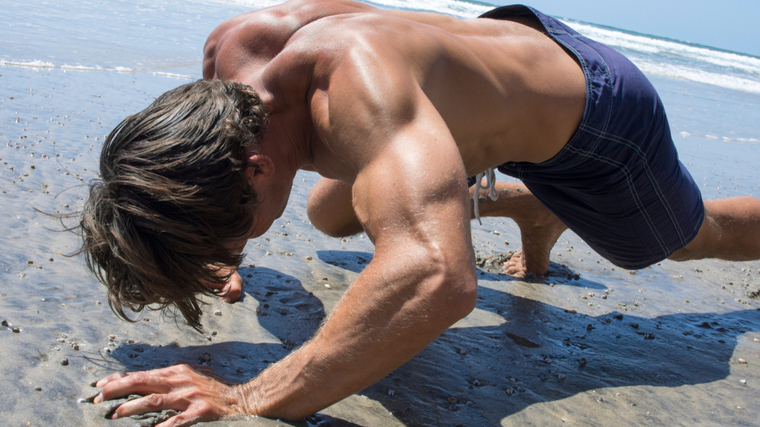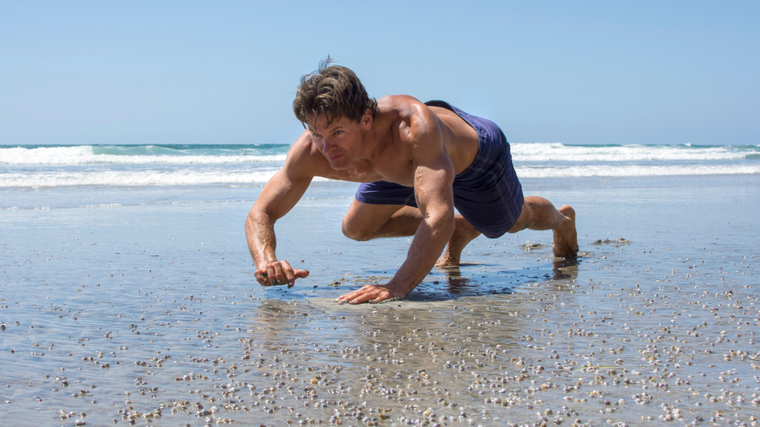Ever since you were a baby, you’ve had the ability to crawl around on all fours. Although that’s probably not how you get from place to place nowadays, it could be beneficial to add a bear crawl back into your routine.

The bear crawl is a moving plank variation that challenges your core strength and stability. It requires balance and coordination — and if you do it right — it will have your whole body roaring. The bear crawl is becoming increasingly popular among athletes, coaches, and regular gymgoers due to the deceivingly difficult nature of the exercise. It may look simple, but try it for yourself to see how long you can crawl.
- How to Do the Bear Crawl
- Benefits of the Bear Crawl
- Muscles Worked by the Bear Crawl
- Who Should Do the Bear Crawl
- Bear Crawl Set and Reps
- Bear Crawl Variations and Alternatives
- Frequently Asked Questions
How to Do the Bear Crawl
The bear crawl looks easy enough. Just crawl forward, right? Well, there’s a little more to it.
Step 1 – Get in a Tabletop Position
Get on all fours with your hands under your shoulders and your knees under your hips, resembling a table. It’s similar to a plank, but your knees are bent at 90 degrees.

Coach’s Tip: Be sure to tighten your core so you don’t arch your back. This will help prevent potentially painful hyperextension or raising your hips too high for the movement to be effective.
Step 2 – Lift Your Knees
Keep your hands and toes on the ground. Lift your knees one or two inches off the ground. Maintain a tight core to help with stability and form.

Coach’s Tip: When you lift your knees, don’t lift your butt, too. Keep it in line with your back to fully engage your core.
Step 3 – Start Crawling
Move your right hand forward as you simultaneously move your left foot forward. Repeat the movement with your left hand and right foot. Continue to crawl forward. Keeping your knees hovering just above the ground the whole time.

Coach’s Tip: Squeeze your core and avoid raising your butt the whole time to help get the most out of the exercise, as well as help avoid injury. Keep your knees close to the ground without touching it.
Benefits of the Bear Crawl
You may not gain the full power of a bear, but there are still plenty of reasons to do the bear crawl. Whether you’re looking for strength, stability, or both, the bear crawl can help provide it.
Builds Core Strength and Stability
Having a strong core isn’t only an aesthetic goal. It can improve your athletic performance and quality of life. You use your core whenever you bend over, twist side-to-side, lift or carry something — activities you likely do everyday.
Studies suggest that core stability is important for standing, sitting, walking, and maintaining steady posture and balance, as well as adding stability to the lumbar spine. (1) In the bear crawl, your core acts as a stabilizer to your entire body, so you can maintain proper form and have enough endurance to keep crawling.
Improves Shoulder Stability
Having healthy shoulders is crucial for helping to prevent injuries in and outside the gym. Your shoulders can help you perform a variety of movements from throwing a ball to reaching for something on the top shelf.
Without shoulder stability, your risk of injury, pain, and limited mobility can increase. Studies suggest that performing shoulder stability exercises can help increase range of motion, shoulder strength, grip strength, and can help prevent shoulder joint damage. (2) Your shoulders play an important role in the bear crawl because they help to support the weight of your upper body and are needed to maintain proper form.
Improves Coordination
The bear crawl is considered a cross-body movement, meaning you’re using the opposing sides of the body to work together. Studies suggest that crawling can be used to assess an array of motor skills, like speed and consistency. (3)
Another study suggests that core stability exercises in general may help improve motor skills. (4) The bear crawl helps with that shoulder and core stability, so you can find yourself with a challenging exercise both for the body and the brain.
Improves Athletic Performance
Core training is popular among athletes and not just for aesthetics. The abdominals help control and transfer force from the upper to the lower body. It also helps protect the spine from heavy loads.
A strong core can help with balance, coordination, and stability throughout the body, which can be crucial when weightlifting or performing sport activities. Studies suggest that optimal core strength can help improve physical and sport performance. (5)
Muscles Worked by the Bear Crawl
Although the core plays a large role in the bear crawl, it’s not the only muscle that is activated by this exercise. Do a couple reps, and you’ll be able to tell it works the entire body.
Rectus Abdominis
The rectus abdominis are the muscles that make up what is commonly known as the “six-pack.” They may be visible only when contracted or when your body fat percentage is low and skeletal muscle is high. Their primary responsibility is to flex the trunk, such as in sit-ups or crunches. These muscles also help to stabilize the spine and control your pelvic movements.
Obliques
Located on either side of the abdominal walls are the obliques. One of their responsibilities is to help rotate your torso. They are also important for posture and helping protect your back and shoulders from injury.
The obliques can be often overlooked if you’re aiming for a six pack look, but it’s crucial to understand that a strong core needs strong sides to support it.
Deltoids
The largest muscle in your shoulder is the deltoid. It’s responsible for arm abduction, flexion, and extension. It helps to stabilize the shoulder joint and helps to prevent shoulder dislocation. Since your shoulders are helping to hold the weight of your upper body as you move forward and hold the position, the bear crawl is a low-impact way to strengthen them.
Quadriceps
Believe it or not, the quads aren’t just worked during squats. Anytime you kick, run, jump, or even stand up from a chair, you’re using your quads. They’re important for supporting your knees and keeping you balanced. In the bear crawl, your quads have to work to keep your knees lifted off the ground and help to stabilize your whole body.
Who Should Do the Bear Crawl
The accessibility of the bear crawl is just one of the benefits that makes it popular, and so many lifters could benefit from it.
Runners
Although you probably won’t be running your race on all fours like Devon Lévesque, the bear crawl can help provide the core strength and stability to give you an extra boost. Studies suggest that improving core endurance can help improve running form and performance due to more controlled movement and better breathing. (6)
Powerlifters
If there’s one thing that’s going to help you get that next PR, it just might be the strength and stability in your core. The squat and the deadlift are two of the three major moves in powerlifting competitions, and your core plays an especially important part in a safe and effective lift.
View this post on Instagram
[Read More: The Best Upper Body Exercises and Workouts]
Studies suggest that core strength and stability can help reduce the risk of injuries and can help improve strength performance. (7)
Olympic Weightlifters
One of the competition lifts in Olympic weightlifting is the clean & jerk. During this powerful exercise, muscle groups throughout your body are activated — including your abdominals. They help stabilize your spine and maintain balance through the movement. Studies suggest that improving core stability can help maximize power, improve balance ability, and reduce the risk of injury. (8)
Bear Crawl Sets and Reps
The bear crawl can be used in different ways depending on what your goals are. Below are just a few set and rep recommendations for how to implement bear crawls into your workout.
For Endurance
Although you probably won’t be bear crawling a marathon, it has been done. Typically, to increase your endurance in any exercise, you have to continue to build on it. For the bear crawl, that doesn’t necessarily mean you need to crawl for hours. It can be beneficial to crawl for 15 to 30 seconds at a time until you can build up to more. Try this for six to eight sets with 20 second rests in between. Once you’re ready, continue to crawl for longer than 30 seconds.
For Strength
The bear crawl is a great way to build shoulder and core strength. When done properly, it can also help improve other areas of performance. Isometric training can help build strength as well, and you can apply this method to the bear crawl. To help build strength, crawl for 10 seconds and hold the bear plank for 10 seconds. Rest for 30 seconds and repeat for three to five sets.
For Dynamic Warm-up
You may be adding the bear crawl to your workout routine, or you may be using it to warm-up for a heavy squat or overhead press day. Since the bear crawl recruits a lot of the muscles needed in big lifts, you can use it to get your muscles warm for the workout.
When you’re only in the warm-up, you don’t want to tire yourself out too much. Bear crawl forward for 20 total steps for two rounds with a 20 second rest in between.
Bear Crawl Variations and Alternatives
Believe it or not, there is more than one way to crawl. These variations and alternatives help to change up your workout and provide modifications or challenges.
Bear Plank
The bear crawl can be difficult to master properly. You may not be totally ready to move yet, and that’s okay. Start with the bear plank.
This can help you build up the strength in your core, shoulders, and quads needed to crawl. It can help you get used to the proper form, so when you are ready to start moving, you can know you’re getting the most out of it.
Reverse Bear Crawl
This variation may require a little more coordination since you’re crawling backwards. Although you’re using the same muscles as you would going forward, the reverse bear crawl can be more challenging because it’s not a direction your body is used to going.
Try this variation if you’re looking for more of a challenge after you’ve mastered the forward crawl.
Dumbbell Bear Crawl
You can make almost any bodyweight exercise more challenging by adding dumbbells. The bear crawl is no different. For the dumbbell bear crawl, you’ll hold dumbbells in your hands and lift them as you move forward.
By adding the extra resistance, you can increase the demand and intensity of the original exercise, and it’s a great way to build even more strength.
Lateral Bear Crawl
Lateral movements can help improve coordination and balance. This may be more of a challenge since we’re more used to moving forward and backward instead of side-to-side.
In the lateral bear, you’re crawling laterally, which can test your balance more than the forward bear crawl. It also may take a little extra coordination since you’re still moving the opposite foot and hand at the same time.
FAQs
Sometimes the exercises that look the easiest turn out to be the hardest. If your questions haven’t been answered yet, check out the FAQs below.
Why does my butt keep rising when crawling?
Much like in a plank, if your core is not strong enough yet, it can be hard to keep your back flat. If this is the case, start with a modification — like the bear plank — until you can build the strength to start moving. You may also not even realize you’re doing it, so watching yourself in the mirror is a great way to be more conscious.
How do I keep my hips from moving side-to-side?
You want to try to avoid wiggling in your hips as you move. If you find they’re moving too much, your steps may be too big. Try shortening your steps until your hips no longer sway.
Is the bear crawl cardio?
Although it may seem like a strength exercise, the bear crawl can absolutely get your heart rate up for a great cardio workout. To emphasize the cardio benefits, try crawling for longer periods of time or go a little bit faster, but make sure to maintain good form throughout.
Final Thoughts
Building animalistic strength isn’t easy — and you definitely should not try to crawl alongside a bear — but the bear crawl in the gym or at home can help you build strength and stability. The one thing that may be limiting you from getting that next PR could be your lack of core stability, so get to training your core. Moves like the bear crawl are more important than you may think.
References
- Hsu, Shih-Lin, Oda, Harumi, & Shirahata, Saya. Effects of core strength training on core stability. Journal of Physical Therapy Science. 2018; 30(8). doi: 10.1589/jpts.30.1014
- Choi, Seok-Hwa, Lee, Byoung-Hee. Clinical Usefulness of Shoulder Stability Exercises for Middle-aged Women. Journal of Physical Therapy Science. 2013; 25(10). doi: 10.1589/jpts.25.1243
- Cole, Whitney G., Vereijken, Beatrix, & Young, Jesse W. Use it or lose it? Effects of age, experience, and disuse on crawling. Dev Psychobiol. 2019; 61(1). doi: 10.1002/dev.21802
- Au, Mei K, Chan, Wai M, & Lee, Lin. Core stability exercise is as effective as task-oriented motor training in improving motor proficiency in children with developmental coordination disorder: a randomized controlled pilot study. Clinical Rehabilitation. 2014. https://doi.org/10.1177/0269215514527596
- Afandi, Mohamed Azizul Mohamed, Mohamad, Nur Ikhwan, & Fazila, Nor. The Relationship between Core Strength Performance with Sprint Acceleration. Journal of Physics: Conference Series. 2021.
- Hung, Kwong-Chung, Chung, Ho-wa, & Chung-Wah Yu, Clare. Effects of 8-week core training on core endurance and running economy. Plos One. 2019; 14(3). doi: 10.1371/journal.pone.0213158
- Hibbs, Andrea, Thompson, Kevin G., & French, Duncan. Optimizing Performance by Improving Core Stability and Core Strength. 2008; 38(12). DOI:10.2165/00007256-200838120-00004
- Judge, Larry W. Core Training for Superior Sports Preparation. Journal of Coaching Education. 2008. 1(2).
Featured Image: Prostock-studio / Shutterstock